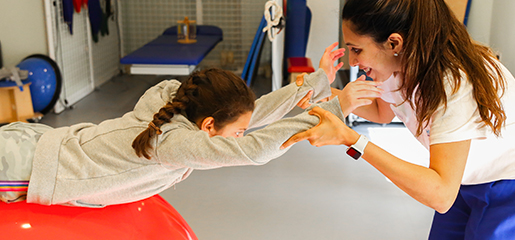

Ball dynamics in pediatric physiotherapy

Kunali Doshi
DHA License Number: 00100771-002
Senior Pediatric Physical Therapist

Introduction
The ball has been used in physical therapy for about 60 years. It is an indispensable tool for physical therapists around the world in rehabilitation of orthopedic and neurological conditions. It is commonly known as the Swiss ball; although they were made in Italy. Klein Vogelbach’s analytical work is a concept of functional kinetics that is based on observing, analyzing, and teaching human movement. She integrated the use of ball and functional kinetics to develop exercises using the ball whilst working with children with cerebral palsy and other neurological disorders.
What does it target?
There are interconnections between the various portions of the central nervous system (CNS). These connections in the CNS get activated when using the Swiss ball for exercises. The Swiss ball can be used to enhance motor control, stimulate sensory motor systems, and activate the limbic system, which motivates the child to facilitate and produce movement. Hence, all these sub- systems can be tapped into ,following injury to the CNS, in order to achieve maximum degree of restoration in the cortical, subcortical, and spinal circuits that control the motor output.
What makes it so different from other tools?
A ball moves in all directions and provides a dynamic surface that can influence alignment of different segments of our body, such as weight shifting, elongation, trunk rotation, rib cage mobility, proximal stability of joints, distal control of limbs, limb dissociation, midline orientation, base of support, center of gravity, balance reactions, symmetry, muscle strength, and core stability. All these components of posture and movement are the pillars to achieving gross motor, fine motor, or oromotor milestones. Even after damage to the CNS, therapy can make the brain relearn, rewire, and form new pathways using movement.
A physical therapist improves rib cage mobility and breathing that is required for speech production or engages the trunk and shoulder muscles that eventually improve reaching and grasping for upper limb function. With a small weight shift on the hips, therapists can better stabilize a child’s core in the trunk, head, and neck, which leads to better organization of the oromotor musculature and your lips. This makes ball exercises a transdisciplinary tool.
How is it used in physical therapy?
As physical therapists, we are multitasking all the time and using our hands as key points of control to facilitate or inhibit different body systems. We can be working on the musculoskeletal system to increase joint mobility, improve joint integrity, muscle length, and flexibility and move onto the neuromotor system that addresses muscle tone such as spasticity, hypotonia, dystonia, and dyskinetic movements. The sensory systems (i.e. visual, vestibular-proprioceptive system, auditory, and somatosensory systems) are being worked on indirectly and alongside the musculoskeletal and neuromotor systems. The over-responsive or under-responsive child can be aroused or calmed depending on the input provided on the ball.
The way the ball moves determines how the body moves and responds to it. It brings out a displacement and weight shift in one body segment that influences the next and then eventually the entire body. The ball also distributes the body weight across its surface, which makes it easier for the therapist to control and facilitate movement patterns.
The body has an innate ability to work itself depending on the feedback and feedforward system of control. This helps evoke different responses desired by the therapist from a child using the ball. There is an abundance of repertoire one can achieve in the form of movement, transitions, static postures, increased range of motion, better muscle lengthening, joint mobilizations, weight bearing, gaining core strength and stability, balance, coordination, and functional skills.
There is not one system that can be worked on individually. Multiple impairments are addressed using one tool, which makes it challenging for the child as well as fruitful for therapist within minutes of therapeutic exercises carried out on the ball.
Choosing the right size, shape, and firmness
Shape
Round balls move in all directions and are used to gain more movement and the therapist can control it completely. Peanut balls move only in two directions and are more stable.
Size
To sit on the ball, hips and knees should be at 90 degrees or the femur parallel to the floor for most activities. For some activities, the child needs to sit on a taller ball to increase weight bearing through feet. If the child is not sitting, a bigger ball can raise the child to the therapist’s level for biomechanics. If the child is lying prone, supine, or sitting with feet not touching the floor, the size of the ball changes the size of the support surface.
Firmness
Therapists can alter activities on the ball by either inflating or deflating it to change its firmness. A very firm ball can give more sensory input but decreases the size of the base of support and therefore increase demands for control. A more deflated ball increases the size of the base of support and therefore can decrease demands on the postural control.
A few exercises to get you started
- Sitting in a 90-90 position and bouncing with feet on the ground enables work on ankle strength and mobility.
- Prone (lying on stomach) arm extension on the ball activates deep extensor muscles of back and glutei.
- Rolling to sit from prone improves core abdominal strength.
- Weight shifting side to side is used to gain hip stability necessary for standing and walking.
- Fast, repetitive banging of upper limbs on sides of ball in prone lying activates fast twitch motor units in arms.
Sources:
Beate Carrière, R. Tanzberger(1998),The Swiss Ball: Theory, Basic Exercises and Clinical Application
Louis Bly, M.A, PT, and Allison Whiteside, PT(1997) Facilitation techniques based on NDT Principles, San Antonio, Texas
Kim Barthel, OTR (2004), Evidence and Art, Labyrinth Therapies, Victoria, B.C
www.labyrinthjourneys.com


